Engineering:Canadair North Star
| North Star | |
|---|---|
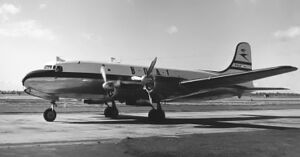
| |
| BOAC DC-4M-4 Argonaut G-ALHS "Astra" at London Airport (Heathrow) in September 1954 | |
| Role | Passenger and cargo transport |
| Manufacturer | Canadair |
| First flight | 15 July 1946 |
| Introduction | 1946 |
| Retired | 1960s (RCAF), 1975 (last civil operator) |
| Primary users | Trans-Canada Air Lines Royal Canadian Air Force Canadian Pacific Air Lines BOAC |
| Produced | 1946 - 1950 |
| Number built | 71 |
| Developed from | Douglas DC-4 |
The Canadair North Star is a 1940s Canadian development, for Trans-Canada Air Lines (TCA), of the Douglas DC-4.[1] Instead of radial piston engines used by the Douglas design, Canadair used Rolls-Royce Merlin V12 engines to achieve a higher cruising speed of 325 mph (523 km/h)[2] compared with the 246 mph (396 km/h) of the standard DC-4. Requested by TCA in 1944, the prototype flew on 15 July 1946. The type was used by various airlines and by the Royal Canadian Air Force (RCAF). It proved to be reliable but noisy when in service through the 1950s and into the 1960s. Some examples continued to fly into the 1970s, converted to cargo aircraft.[3]
Design and development
Canadair Aircraft Ltd. took over the Canadian Vickers Ltd. operations on 11 November 1944. Besides the existing Consolidated PBY Canso flying patrol boats in production, a development contract to produce a new variant of the Douglas DC-4 transport was still in effect. The new Canadair DC-4M powered by Rolls-Royce Merlin engines mounted in Rolls-Royce Universal Power Plant (UPP) installations[4] emerged in 1946 as the "North Star." More than just an engine swap, the North Star had the Douglas DC-6 nose and landing gear and fuselage (shortened by 80 inches (6.7 ft; 2.0 m)); a DC-4 empennage, rear fuselage, flaps and wing tips; C-54 middle fuselage sections, wing centre- and outer-wing panels, cabin pressurisation, and a standardised cockpit layout with a different electrical system.
Canadair built 71 examples of what was officially called the Canadair Four under the designations: North Star, DC-4M, C-4 and C-5. With the exception of the single C-5 (which had Pratt & Whitney R-2800 engines, as fitted to the Douglas DC-6), these variants were all powered by Rolls-Royce Merlin engines and 51 of the production examples were pressurised.
Operational history
Trans-Canada Air Lines (TCA), the Royal Canadian Air Force (RCAF), Canadian Pacific Airlines (CPA) and British Overseas Airways Corporation (BOAC) were the principal operators of the "North Star", with the CPA examples known as the "Canadair Four" and BOAC examples known as the "Argonaut".
RCAF service
The RCAF North Stars were unpressurized and were used on a variety of transport duties. Like other North Stars, they were notorious for the high level of cabin noise caused by the Merlin engines, as unlike the radials of the DC-4, the exhaust from the individual cylinders is not collected and exhausted via a single outlet, but instead exits the separate individual ejector-exhaust stubs in high-pressure bursts.
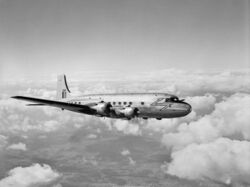
In an effort to reduce cabin noise, the sole C-5 variant was powered by Pratt & Whitney R-2800 Double Wasp engines that were considerably quieter.[5] The only C-5 was delivered to the RCAF in 1950, entering service with No. 412 Transport Squadron RCAF in Uplands, Ottawa, specially outfitted for the transportation of VIP passengers. It was used to transport the Canadian Prime Minister, the Queen, and numerous other dignitaries on various high-profile missions, serving faithfully for 17 years, later becoming a crew trainer before being retired and sold in the United States.
North Stars were also employed by 412 Squadron RCAF on various VIP transport duties and, overall, the aircraft provided valuable and reliable long range transport services for the RCAF. From 1950 to 1952, during the Korean War, RCAF North Star aircraft were employed ferrying supplies to Korea across the Pacific Ocean. They flew 599 round trips over the Pacific and delivered seven million pounds of cargo and 13,000 personnel on return trips. They flew 1.9 million miles without a fatal crash and outhauled the United States Air Force C-54s on the Korean run. After 1967, the remaining North Stars were assigned to No. 426 Transport Squadron RCAF initially deployed to Dorval, Quebec and then to Trenton, Ontario. Gradually, their service life diminished in the 1970s and most were declared surplus.
TCA and BOAC operations
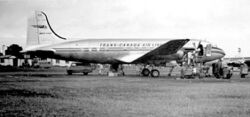
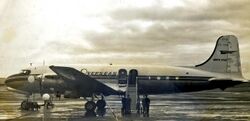
TCA received its fleet of twenty DC-4M-2 North Stars during 1947 and 1948 and operated them on routes within Canada and to the USA until 1961. Starting in 1954 the North Stars were replaced on TCA's routes to Europe by Lockheed Super Constellations. To deal with passenger complaints about noise, TCA engineers developed a cross-over for the fuselage-side exhausts that reduced cabin noise by 6-8 decibels.[6][7] "In the cabin, noise is reduced to 102 decibels near the windows and 93 at the aisle."[8]
BOAC ordered 22 DC-4M-4s and named them the "Argonaut class", each aircraft having a classical name beginning with "A". The Argonauts were delivered between March and November 1949; they flew to South America, Africa, the Middle East and the Far East from London Heathrow Airport until 1960.
On 1 February 1952 the BOAC Argonaut Atalanta G-ALHK transported Princess Elizabeth and the Duke of Edinburgh to Kenya to begin a Commonwealth tour.[9] Some days later, 6 February, it was again Atalanta G-ALHK which returned the newly acceded Queen Elizabeth II to England upon the death of her father, King George VI.[10][11]
Rolls-Royce also developed a quieter 'cross-over' exhaust system for the DC-4M, the modifications being supplied in a kit allowing installation on the aircraft by the operator. The engine thus modified became the 'Merlin TMO' in contrast to the unmodified engine, the Merlin TML - Transport Merlin L. The modified exhaust conferred an increase in horsepower over the unmodified system of 38 hp, resulting in a 5 knot improvement in true air speed. Sound levels were reduced by between 5 and 8 decibels. Still air range of the aircraft was also improved by around 4 per cent. BOAC Argonauts initially, due to schedules being unable to be changed, had only the inner engines so-modified, the remaining outer engines being changed to the new exhaust system when time was available.[12]
Later service
After service with TCA and BOAC, the surplused North Stars and Argonauts had long careers with secondary operators such as British Midland Airways, Overseas Aviation and other charter companies. Cargo conversions of available airframes also lengthened the service life of Argonauts and North Stars.CF-UXA, ex-RCAF 17510 was the last DC-4M in airline service, completing its final flight on 19 June 1975 at Miami, Florida. Despite the onset of jet airliners in the 1950s, the rugged Canadair North Star found a niche in both military and civil use.[3]
Variants
Canadair built 71 examples under the designations: North Star, DC-4M, C-4 and C-5. With the exception of the single C-5 (which had Pratt & Whitney R-2800 engines, as fitted to the Douglas DC-6), these variants were all powered by Rolls-Royce Merlin engines and 51 of the production examples were pressurised.
- DC-4M.1
- Initial variant as designed for Trans Canada Airlines (TCA); at least 5 built for TCA.
- DC-4M.2
- Pressurised higher take-off weight version.
- North Star
- Name for series.
- Argonaut
- BOAC name for North Star
- C-4
- C-5
- Powered by 4 Pratt & Whitney R-2800 radial engines
- CL-29
- 1949 maritime patrol aircraft proposal made in anticipation of RCAF requirements, with a stretched fuselage and re-engined with three engine options. Eventual 1952 RCAF specifications were for a much more capable aircraft though and the Bristol Britannia would be used as the basis instead.[13]
Operators
Accidents and incidents
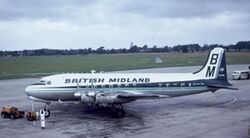
On 8 April 1954, a Royal Canadian Air Force Canadian Car and Foundry Harvard Mk.II 3309 collided with Trans-Canada Airlines North Star CF-TFW over Moose Jaw, Saskatchewan, killing 36 people aboard the aircraft and one person on the ground.[citation needed] [14] As a result of this crash, training flights are restricted south of the Trans Canada Highway and civil aviation transit north of the highway.
On 21 September 1955: BOAC Argonaut G-ALHL which was traveling from Rome to Tripoli crashed on its fourth landing attempt in poor visibility and strong winds. Fifteen of the 40 occupants died when the aircraft descended too low, struck trees approximately 1,200 ft short of runway 11 and subsequently impacted terrain.[15]
On 24 June 1956: BOAC Argonaut G-ALHE crashed shortly after taking off from Kano Airport, Nigeria into a thunderstorm, killing 29 of the 38 passengers and three of the seven crew members.
On 9 December 1956: Trans-Canada Air Lines Flight 810 crashed into Mount Slesse on a flight from Vancouver to Calgary, killing all 62 people on board the aircraft. Among the dead were five Canadian Football League players, including four members of the Saskatchewan Roughriders and one member of the Winnipeg Blue Bombers, as well as a CFL official returning home from the previous day's annual All-Star game at Empire Stadium in Vancouver.
On 11 October 1966, CF-TFM/HP925 crashed near Garoua, Cameroons, carrying spurious registration I-ACOA, believed to be carrying a cargo of machine guns bound for Burundi. Ex- Overseas Aviation, bought at Gatwick by Mike Keegan, it had been ferried to Coventry for onward sale; under new ownership, flown to Newcastle (UK), with a subsequent long-term stay parked adjacent to the wooden control tower and subject to a restraining Court Order. Eventually re-registered in Panamanian markings, it was flown to Limburg, Netherlands, but ended up being involved in various arms shipment flights to West Africa. After the accident, the movements of this aircraft were investigated and extensively reported by, it is thought, the Sunday Times newspaper. Re-registration history and movements after leaving NCL courtesy of Propliner magazine's website.[16][verification needed]
On 4 June 1967, Argonaut G-ALHG, owned by British Midland Airways, crashed near the centre of Stockport, Greater Manchester, United Kingdom . Fatalities included 72 of the 84 on board; 12 others were seriously injured.
Surviving aircraft

The sole surviving airframe in existence is an RCAF C-54GM example (17515 ), which is currently undergoing restoration at the Canada Aviation and Space Museum, Ottawa, Ontario.[17][failed verification]
Specifications (C-4)
Data from Jane's All the World's Aircraft 1951–52[18]
General characteristics
- Crew: 7
- Capacity: 55 passengers
- Length: 93 ft 7 1⁄2 in (28.537 m)
- Wingspan: 117 ft 6 in (35.81 m)
- Height: 27 ft 6 5⁄16 in (8.390 m)
- Wing area: 1,457 sq ft (135.4 m2)
- Aspect ratio: 9.48:1
- Airfoil: NACA 23016/23012
- Empty weight: 46,832 lb (21,243 kg)
- Max takeoff weight: 82,300 lb (37,331 kg)
- Fuel capacity: 3,226 imp gal (3,874 US gal; 14,670 L)
- Powerplant: 4 × Rolls-Royce Merlin 626 liquid-cooled V-12 engines, 1,760 hp (1,310 kW) each
- Propellers: 3-bladed Hamilton Standard constant-speed propellers, 13 ft 1 in (3.99 m) diameter
Performance
- Cruise speed: 325 mph (523 km/h, 282 kn) at 25,200 ft (7,700 m)
- Range: 3,860 mi (6,210 km, 3,350 nmi) (absolute range)
- Service ceiling: 29,500 ft (9,000 m)
- Rate of climb: 840 ft/min (4.3 m/s)
See also
Related development
Aircraft of comparable role, configuration and era
Related lists
References
- Notes
- ↑ "Here and There: Merlin-engined Skymasters". Flight XLVI (1856): 60. 20 July 1944. https://www.flightglobal.com/pdfarchive/view/1944/1944%20-%201466.html. Retrieved 29 November 2017.
- ↑ Pearl, Roy (25 March 1948). "A Visitor's Impressions: Canada's Production and plans for the Future". Flight LIII (2048): 339–340.
- ↑ 3.0 3.1 Milberry 1982, pp. 213–214.
- ↑ "Universal Power Plants". Flight: 157–162. 13 February 1947. https://www.flightglobal.com/pdfarchive/view/1947/1947%20-%200229.html. Retrieved 29 November 2017.
- ↑ "Canadair North Star 1 ST." Canada Aviation Museum. Retrieved: 18 March 2011.
- ↑ "Canadair C-54GM North Star 1 ST". https://ingeniumcanada.org/artifact/canadair-c-54gm-north-star-1-st.
- ↑ Aviation Week 7 Sept 1953 p53: "Crossovers reduce cabin noise level in the audio range by about 6–8 decibels."
- ↑ American Aviation 12 May 1952 p28
- ↑ "King and Queen See Royal Departure", BBC TV (first broadcast) 1 February 1952 BBC Archive
- ↑ "The Queen's return", Flight (193), 15 February 1952, http://www.flightglobal.com/pdfarchive/view/1952/1952%20-%200425.html
- ↑ "Queen Elizabeth II dressed in mourning descends the steps of the plane that returned her from Africa to London. Prince Philip is five steps behind" San Francisco Sentinel
- ↑ "1952 | 0532 | Flight Archive". http://www.flightglobal.com/pdfarchive/view/1952/1952%20-%200532.html.
- ↑ Pickler, 1995, p.120
- ↑ "ASN Aircraft accident Canadair C-4-1 North Star CF-TFW Moose Jaw, SK". https://aviation-safety.net/database/record.php?id=19540408-1.
- ↑ "ASN Aircraft accident Canadair C-4 Argonaut G-ALHL Tripoli-Idris Airport (TIP)." Aviation Safety Network. Retrieved: 26 June 2011.
- ↑ "Propliner" website; Sunday Times
- ↑ "Canadair C-54GM North Star 1 ST". http://ingeniumcanada.org/artifact/canadair-c-54gm-north-star-1-st.
- ↑ Bridgman 1951, pp. 102c–103c
- Bibliography
- Berry, Peter et al. The Douglas DC-4. Tonbridge, Kent, UK: Air-Britain (Historians) Ltd, 1967.
- Blewett, R. Survivors. Coulsden, UK: Aviation Classics, 2007. ISBN:978-0-9530413-4-3.
- Bridgman, Leonard. Jane's All The World's Aircraft 1951–52. London: Sampson Low, Marston & Company, Ltd, 1951.
- Eastwood, Tony and John Roach. Piston Engine Airliner Production List. West Drayton, UK: Aviation Hobby Shop, 1991. ISBN:0-907178-37-5.
- Francillon, René. McDonnell Douglas Aircraft Since 1920: Volume I. London: Putnam, 1979. ISBN:0-87021-428-4.
- Milberry, Larry. The Canadair North Star. Toronto: CANAV Books, 1982. ISBN:0-07-549965-7.
- Pearcy, Arthur. Douglas Propliners: DC-1–DC-7. Shrewsbury, UK: Airlife Publishing, 1995. ISBN:1-85310-261-X.
- Pickler, Ron and Larry Milberry. Canadair: The First 50 Years. Toronto: CANAV Books, 1995. ISBN:0-921022-07-7.
- Yenne, Bill. McDonnell Douglas: A Tale of Two Giants. Greenwich, Connecticut: Bison Books, 1985. ISBN:0-517-44287-6.
External links
- Archival footage of Canadair North Star in service with the RCAF
- Project North Star - restoration of North Star 17515
- Project North Star - restoration of North Star 17515, Canada Aviation and Space Museum web page
- Berlin Airlift Historical Foundation - Operates C-54 "Spirit of Freedom" as flying Berlin Airlift Museum
- "Canadair Four" a 1947 Flight article on the DC-4M
- "Only The Canadair-Four Offers ... " a 1948 advertisement in Flight
- "A Call on Canadair" a 1949 Flight article on the C4 - part 1
- "A Call on Canadair" a 1949 Flight article on the C4 - part 2
- "Quieter Argonaut" a 1952 Flight article on the Rolls-Royce exhaust system
 |

